What is ‘Ivanka Vacuuming’?
At Flashpoint Gallery, viewers are invited to throw crumbs for a former first daughter look-alike to vacuum clean for two hours. Surrounded by three walls reflecting the bright pink carpet, a model with striking resemblance to Ivanka Trump performs Jennifer Rubell’s new performance piece titled, ‘Ivanka Vacuuming’. Dressed in a pink dress and stilettos, the model’s constant smile or impassivity- reacting to nothing while silently cleaning up the mess created for her by the audience, garnered attention. The work, which appears to be satirical in nature, has sparked discourse surrounding power, femininity, and its portrayal, as well as the construction of identities. The real-world implications and undertones of such a piece- featuring the politics and privilege in art ownership, and Ivanka Trump herself- have all been dug up into public view owing to the performance.
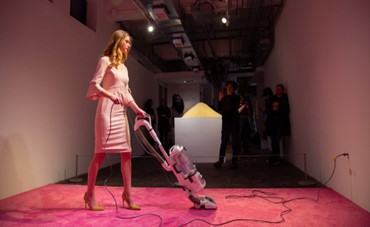
Source: The Atlantic
Unravelling Identity and Public Image
Rubell’s ‘Ivanka Vacuuming’ has been described at the exhibition as follows: “visual celebration of a contemporary feminine icon; a portrait of our own relationship to that figure; and a questioning of our complicity in her role-playing.” The piece seeks to draw the eye to discontinuities and hypocrisies that exist between the public image and reality. The carefully constructed public identity of Ivanka Trump includes that of the all-American, layperson that every working woman can relate to. The cautiously curated brand had the purpose of creating mass appeal as she took on more public positions in the government with policies that were aimed at the welfare of women. She appears to be the model of efficiency, exercising the perfect amount of restraint and was once in the public eye slightly separated from the problematic identity of her father.
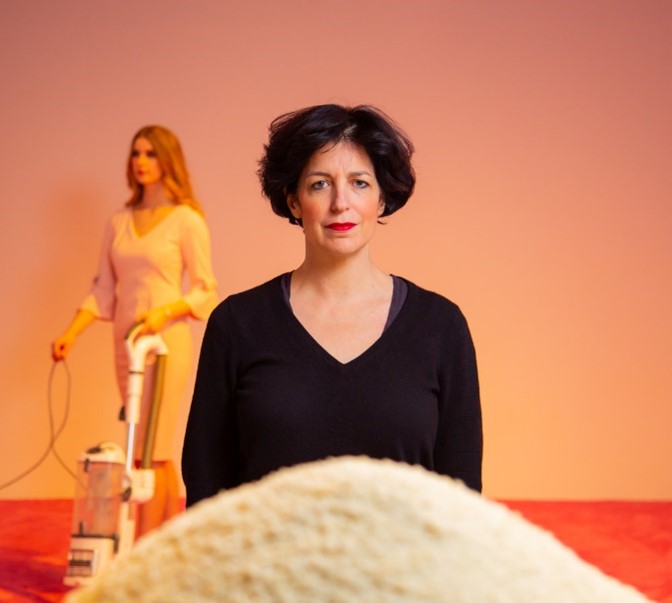
Source: Cultural DC
Yet, the piece traps her- reducing her role to someone stuck in the never-ending chore of cleaning up, represented through the traditional image of a wife engaged in cleaning. The act of cleaning is also a reference to the role of fixing political mishaps within the Trump administration that she was associated with, according to the artist. Rubell also notes in this identity, a portrayal of the modern feminine- what does it look like to be an efficient woman in the present day? Whether juggling work and home or simply engaging in constant servitude- it does not paint a flattering reality despite the constructed ideals.
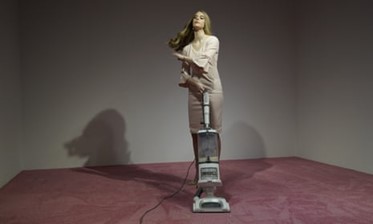
Source: The Guardian
Another example of incongruence is reflected in the increasingly sour relationship between Ivanka Trump and the art community, which is an important aspect of her personal brand. Trump has worked to actively cultivate, in public perception, her image as an avid art collector and supporter of rising artists. As noted by The Guardian, this connection with the art community has undergone strong tensions owing to her support of the Trump administration’s policies that were anything-but-liberal at best, and human rights violations at worst. ‘Dear Ivanka’ was a group that campaigned together, requesting artists whose work was featured on her socials to “challenge the White House adviser on her hypocrisy”. While artists like Israel commented an appeal to Trump, requesting her to stand with artists and equality in the country, artists like Alex Da Corte declared, “I am embarrassed to be seen with you.”, demanding Trump take his art off their walls. The world of art, thus, seems to have rough ties with Trump, with the field of performance art becoming a platform to explore the same. This strained relationship with the artists once again reveals parts of her public image that fall apart under scrutiny. The impermanence of the facade and its hypocrisy is what is being drawn at by Rubell.
Trump’s Response and Allegations of Sexism
Ivanka Trump responded to the exhibit on Twitter, “Women can choose to knock each other down or build each other up. I choose the latter.” The response is important as Trump usually refrains from commenting on such matters- maybe implying that this piece truly caused harm personally and to her brand. This raises a very important moral question that has been asked for centuries prior- where does the line lie when satire and public messages involve real, living people? While Ivanka Trump’s stances are deserving of criticism, there is something unsettling about dressing someone in identical clothes (her outfit at the last G20 Summit) and making them submit to a power play initiated by an audience.
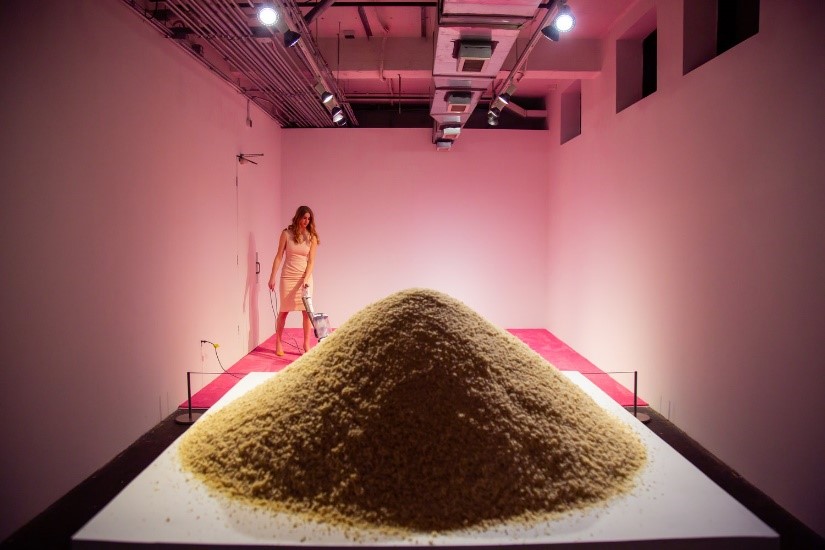
Source: Cultural DC
The allegations of sexism, also made by her brother, makes the viewer wonder if the piece is a distorted application of feminism- is the woman simply being reduced to the vacuuming figure a reinforcement of the stereotype? The Atlantic notes, however, “Rubell is placing her near-flawless public presentation at odds with her stated intentions, asking whether Trump, as a persona, conflates femininity with feminism.” This too, however, causes a conflict between the intended message and what actually comes through to the public consciousness. The work, which encourages audience participation, also relies on what the audience wishes to decipher from the given scenario- so when a power imbalance is introduced, is the nuanced understanding of femininity lost in the overt, more accessible images of convention?
Audience Participation
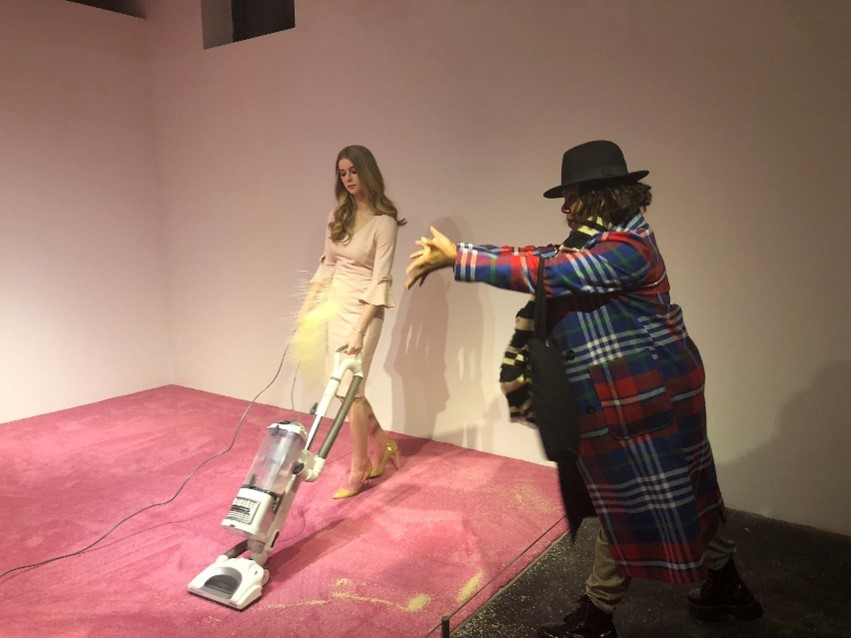
Source: dcist
As mentioned above, the audience are encouraged to throw panko breadcrumbs kept in front of the stage as Ivanka vacuums. The model then cleans it up, constantly engaged in an act of service that is worsened by those that are being served. Rubell notes, according to @Catastrophe on Instagram, that the audience takes pleasure in throwing crumbs- one enjoys the power of being able to elicit a specific response. However, the fact that she continues vacuuming- whether one throws the crumbs or not- also helps one feel less accountable for the same. This complex exploration of human behaviour is also at the crux of the project where, when given the right to do so, humans shall find pleasure in enforcing this Sisyphus reminiscent task on ‘Ivanka’. Other interpretations to the image- involving the ideas of class and capitalism that feature in Rubell’s other works- are also present here. The difference in class that has very real consequences in everyday society-between the viewer and someone with the status of Trump- does not exist in the piece, ‘Ivanka’ vacuums crumbs thrown by any member of the gallery.
So, What does this Exhibit Mean?
Like many pieces of performance art, this too aims to make the viewer think about overlapping social realities. Seemingly simple, the work unwraps the notions of curated social identity through the example of Ivanka Trump. It carves a shelf for the feminine- how it is represented and treated, both by societal norms and by the audience with agency. How the work interacts with the viewers is a marker of social behaviour. Rubell perhaps sums it up best when asked if there would be disappointment in case of low participation, “I don’t assume anything,” she says. “I find it all valid, all interesting. I’m constantly surprised.”
SOURCES
- The Atlantic: Ivanka Vacuuming
- DCist: You Can Throw Breadcrumbs at this Ersatz Ivanka Trump and Shell Vacuum Them Up
- The Guardian: Ivanka Trump and The Art of Cleaning Up
- Public Delivery: Jennifer Rubell Ivanka Vacuuming
Read More:

Contributor




